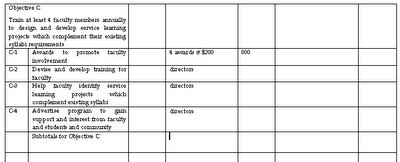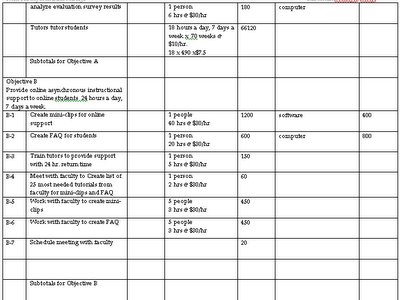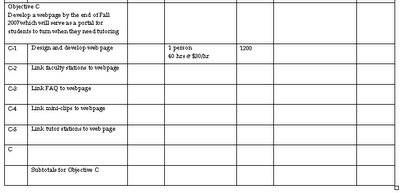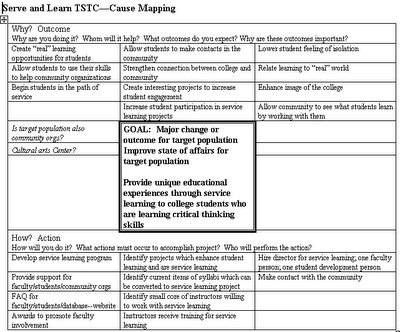Grant Writing Blog
I am a wife and mother of two, an 8-yr-old who loves airplanes and is learning to fly using a flight simulator and a 5-yr-old girl who can't wait to grow up. I have been in an academic environment all my life. After college, I taught English at a high school in Brownsville, Tx (my hometown) and stayed "in the trenches" for 8 years. In 2002, I moved to TSTC, Harlingen. I teach Comp and Tech Writing. My interest is researching strategies which help students be successful in first-year classes.
About Me
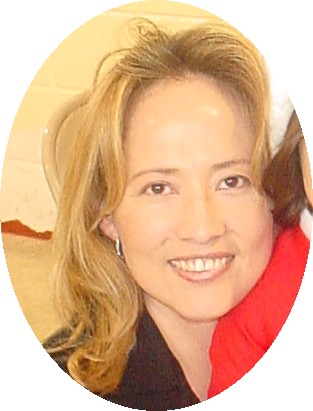
- Name: Prof Santoy
I have been in the classroom, in one way or another, all my life. After 6 years of only being a teacher, I realized I miss the other side of the classroom. Because I have two young children and cannot take the joy of an extended family from them, I chose to pursue my degree online.
Monday, March 20, 2006
Monitoring and Reporting--Writing SOS
Implementation status reports, periodic evaluations, financial updates,
2. To help you think about the reporting system you will design, answer the following questions:
What kinds of information will you need to capture?
Qualitative Data--gather questionnaire from students, from faculty, from tutors; problems by tutors; suggestions by users
Quantitative Data--Track usage,
Pre-test tutors to identify skills; train and give post-test
Growth of FAQ; # of hits on website; Growth of instructional mini-clips
How will you capture that information? (What forms will you use? Will you have to create these forms yourself? In what ways will you capture the information? When will this information have to be collected and analyzed?)
Questionnaires—created by…???/captured monthly
Information captured by WebCt; computer; email
Website—created by…
Training evaluations
Who will capture this information? How long will it take?
Computers and director; support personnel
What ongoing information and reports will you be required to monitor and evaluate?
????
How and when will you incorporate what you have learned into the project?
Mid-semester; semester end
What information and reports (if any) will you have to generate that will be required by others—local groups, government, sponsors, consortium partners, stakeholders, and so on.
????
For whom will various reports be written? What information will these groups need and how will they use that information?
Internal for improvement
External????
Who will write these reports and how much time will it take?
Director will write reports; how long—2 weeks
Monitoring and Reporting--LSTSTC
Implementation status reports for current projects, website, community contacts, program development
Periodic evaluations
Financial Updates
2. To help you think about the reporting system you will design, answer the following questions:
What kinds of information will you need to capture?
Quantitative data: number of faculty; number of students; number of organizations; persons benefiting from projects; survey for students; survey for faculty; survey for community orgs.
Qualitative data: student reflections; faculty reflections, community org. questionnaires
How will you capture that information? (What forms will you use? Will you have to create these forms yourself? In what ways will you capture the information? When will this information have to be collected and analyzed?)
Surveys for faculty, students, community orgs need to be created; Forms for reflection need to be created, distributed and collected
Pre-post test; track growth of FAQ
Who will capture this information? How long will it take?
Website can help capture information; webCT; program directors, secretarial staff; will take ½ semester to one semester to compile and then another semester to report;
Information from mid-semester can be used to make improvements, modifications
What ongoing information and reports will you be required to monitor and evaluate?
Surveys and reflection forms for faculty, students and community orgs
How and when will you incorporate what you have learned into the project?
At midsemester and end of semester
What information and reports (if any) will you have to generate that will be required by others—local groups, government, sponsors, consortium partners, stakeholders, and so on.
How many involved; what projects used; program implementation status reports; training developed; how many trained
For whom will various reports be written? What information will these groups need and how will they use that information?
Reports written for internal audience; what sponsor requires ????
Who will write these reports and how much time will it take?
The program directors with the help of secretarial staff; how much time—2 weeks?
Learn and Serve TSTC--Building Sustainability
Building Sustainability
Are you going to seek additional funding?
No
Will the project be self-supporting?
No; but college will benefit from wider contact with community and potential increase of enrollment
Are you building in financial, managerial, technical, or social sustainability?
Financial sustainability: will be able to attract more students and perhaps more donors to college
Managerial sustainability: directors will need to continue working to provide contact and support for instructors, students and community
Technical sustainability: website will be available for continued use and will need continual updating
Social sustainability: students and instructors will learn of the benefits of this project and will continue to want to be involved with the community; and community organizations will be lining up to participate
Objectives/Outcomes/Tasks--Learn and Serve TSTC
1. Restate each objective as an outcome
Goal I: Provide unique educational experiences to college students through service learning
Objectives
A. Increase student participation in service learning by having at least 200 students per semester participate in service learning projects which highlight critical thinking skills
Outcomes
A 200 students will participate in a service learning activity which highlights critical thinking skills each semester
2. See if answers "So what?"
3. If not, identify secondary outcomes
A1 Four faculty members will commit to working with service learning in their classes by the end of the semester
A2 All faculty will have access to online resources which detail service learning project expectations and examples of several course projects
4. What level of attainment would make these outcomes successful?
5. Kinds of monitoring or reporting supporting achievement of outcomes
6. Describe outcomes and explain how they will be monitored and reported
7. Tasks or activities to perform to monitor secondary outcomes
Tasks
A-1: Identify faculty members interested in participating in SL project.
A-2: Develop course and project expectations
A-3: Develop rules for participation
A-4: Develop evaluation methods
B. Develop a service learning program which provides support to on-campus and online students, faculty and community organizations
B-1: Make contact with community members to devise community projects
B-2: FAQ for faculty, students and community orgs--website
B-3: Hire 2 ½-time directors; one faculty; one student development
B-4: Develop system to track student involvement
B-5: Develop system to track faculty involvement
B-6: Develop system to track community org. involvement
B-7: Advertise program in the community
Outcomes B
All students, faculty and community organizations will have access to a service learning program office staffed by two directors which provides support for involvement in projects.
B1 A list of community organizations interested in working with students will be available to students and faculty through the website by the end of Fall 2007
B2 A website will be available for all students, faculty and community organizations which has a FAQ page for each population
B3 System to track student, faculty and community involvement will be implemented by Fall 2007
B4 one story in the community newspaper will be published per semester to help gain community support
C: Train at least 4 faculty members annually to design and develop service learning projects which complement their existing syllabi requirements
C-1: Awards to promote faculty involvement
C-2: Devise and develop training for faculty
C-3: Help faculty identify service learning projects which complement existing syllabi
C-4: Advertise program to gain support and interest from faculty and students and community
Outcomes C
At least four faculty members will be trained to develop and design at least one service learning project for one of their courses
C One award annually will be given to a faculty member who develops and implements an exceptional service learning project
C Training to develop service learning projects will be available to all faculty members who request it
C A database of past and present projects will be available to faculty to help them identify ideas for projects which they can implement
C4 Have 4 stories in the student newspaper published in the Fall semester and three stories in the Spring semester and one story per semester in the staff newspaper ; one story in the community newspaper will be published per semester
Wednesday, March 08, 2006
Writing SOS--Building Sustainability
Building Sustainability
Are you going to seek additional funding?
No
Will the project be self-supporting?
Can use some work-study to staff the lab
Are you building in financial, managerial, technical, or social sustainability?
Managerial--manager will be needed to continue running the lab, hiring the tutors, providing training, etc.
Technical sustainability--equipment will be serviceable for many years
Social sustainability--the first few years will build a demand for this type of service: students will come to expect this type of service; instructors will choose to add this type of service as part of their communication with students
Objectives/Outcomes/Tasks--Writing SOS
Project #1--Online Tutoring Lab
1. Restate each objective as an outcome
Goal I: Help non-traditional students with limited time succeed in their courses by providing writing skills instructional support online.
Outcomes
A 10% of student population will seek and gain synchronous instructional support online per semester
2. See if answers "So what?"
3. If not, identify secondary outcomes
A1 10% of faculty will receive training to provide instructional support online
A2 100% of tutors will receive training to provide instructional support online using on-campus tutoring stations or home equipment
A3 20 student tutoring stations with synchronous capabilities will be available to students
A4 20 tutor stations will be available for tutors to provide synchronous online tutoring
A5 10% of faculty stations will be equipped to provide online synchronous tutoring
A6 10% of faculty stations will be equipped to provide online synchronous tutoring
4. What level of attainment would make these outcomes successful?
5. Kinds of monitoring or reporting supporting achievement of outcomes
Monitoring will include steps for implementation and implementation reports.
6. Describe outcomes and explain how they will be monitored and reported
Total number of stations need to be compiled so that the 10% can be calculated
7. Tasks or activities to perform to monitor secondary outcomes
A-1: Set up tutoring stations with synchronous capabilities
A-2: Train tutors to use technology to provide tutoring
A-3: Devise training for tutors
A-4: Train faculty to provide support online
Devise training for faculty
A-5: Install equipment in faculty stations so they are capable of synchronous support
A-6: Order equipment
Schedule equipment installation
Provide online asynchronous instructional support to online students 24 hours a day, 7 days a week.
B-1: Create mini-clips for online support
B-2: Create FAQ for students
B-3: Train tutors to provide support with 24 hr. return time
B-4: Meet with faculty to Create list of 25 most needed tutorials from faculty for mini-clips and FAQ
B-5: Work with faculty to create mini-clips
Work with faculty to create FAQ
Schedule meeting with faculty
Outcomes
B 10% of student population will seek and receive asynchronous online tutoring
B1 25 mini-clips will be created which provide instruction
B2A list of 25 FAQ will be created to provide instruction
B3100% of tutors will receive training to provide asynchronous tutoring online
Develop a webpage by the end of Fall 2007which will serve as a portal for students to turn when they need tutoring
C-1: Design web page
C-2: Link faculty stations to webpage
C-3: Link FAQ to webpage
C-4: Link mini-clips to webpage
Link tutor stations to web page
Outcomes
C Webpage which serves as a portal for tutoring will be available for all students by Fall 2007
C1 All faculty stations will be linked to webpage
C2 All tutor stations will be linked to webpage
C3 25 mini-clips and 25 FAQs will be available via the webpage to all students by Fall 2007
Wednesday, March 01, 2006
Week 8
Timeline for Project #1--Online Tutoring Lab
- Cover Letter
- Cover Page
- Project Description
To be completed by 3/15
- Solution
- Evaluation and Sustainability
- Budget
- FRP Analysis completed by 4/10
- Rhetorical Analysis completed by 4/24
Timeline for Project #2--Service Learning Project
- Cover Letter
- Cover Page
- Project Description
To be completed by 3/27 - Solution
- Evaluation and Sustainability
- Budget
To be completed by 4/10 - FRP Analysis completed by 4/10
- Rhetorical Analysis completed by 4/24
Week 7
"My first thing is to spend time with key people..."Erin
I have found that talking to people is key not only to establish support for the project but also to find out what other initiatives are going on in the college and who is involved in them.
For the online tutoring lab, I found that a person who I thought would be key is not really interested in working with the project. Even though I think that his position as Student Success Director ties in directly with the project, knowing that he is not interested has led me to some yet unanswered questions and to more conversations with other "key people."
Also, I learned that the student development department is also looking at how to offer support to students online. The goals of both projects are very similar.
So talking with people in the organization is key. I realize that as an academic instructor, I am very insolated and many times want to choose projects which will keep me that way.
These two projects have forced me to go out of my building.




